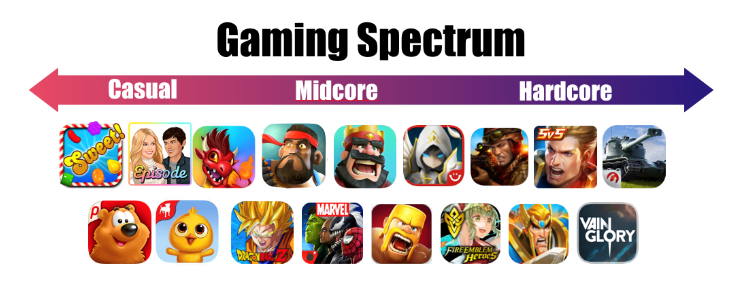In previous articles, we’ve defined the rise of the hyper-casual gaming genre and discussed its massive growth, and we’ve recently seen the resurgence of the hardcore genre as well. As a result, other mobile game genres, particularly midcore titles, are feeling the squeeze. But before we get into why, let’s define our terms.
On one end of the scale are hyper-casual games, which take little time to produce and have a minimalistic interface with instinctive gameplay (no tutorials or onboarding). These games are uniformly lightweight, so people can pick up and play almost instantly. User sessions are short, lifetime value is low, and market acceleration is entirely a factor of virality. As most hyper-casual games rely on ad-supported models, monetization, and profit ramp in line with scale.
On the other end are hardcore games, which are much more heavy duty in terms of file size and take considerably longer to download and begin playing. Hardcore games have more challenging gaming environments that must be mastered over time. Gaming sessions are longer, monetization is through in-app purchases, and LTV can grow quite high—but these depend on a small number of “whales,” big spenders who subsidize other players. Market acceleration has much to do with the depth of the publisher’s pockets.

In between (but a lot closer to the hard side of the spectrum) are midcore games, which, simply stated, offer a lighter take on the hardcore experience: somewhat smaller files, less time to master game play, intermediate session lengths, and LTV on a sliding scale with the most committed gamers driving a majority of monetization through IAPs and some ads.
With those definitions in hand, let’s examine how the rise of hyper-casual and strength of hardcore markets may jeopardize midcore games in 2018.
A change atop the charts
The virality of hyper-casual games is the direct product of their elegant simplicity. As Josh Burns wrote: “Their simple game mechanics makes them instantly playable and infinitely replayable.” Voodoo’s Baseball Boy and Ketchapp’s Dunk Line are excellent examples of this.
By comparison, hardcore games are much more complex to play, often featuring a slew of controls, options, and sub-menus. The gamer is pulled deeply into the game by an engaging narrative development, or, as in the case of popular survival titles, such as PUBG Mobile or Fortnite, the user is compelled to play, stay, and return by the challenge of competing against other users.
Additionally, hyper-casual games lend themselves well to competitive ads. What this means is that hyper-casual’s success is often a result of its publishers running ads within its competitors games. As a publisher, it seems counterintuitive to allow your competitors to run ads within your app, but you can actually monetize via ads for games that are similar to yours. This works well as these ads are more relevant to your users, and they’ll be more likely to click through. There’s no guarantee that your competitors will run your ads in return, but you will certainly generate more revenue by showing more contextual ads. It’s this cross-promotion via ads that allows hyper-casual games to go viral and as a result, drive low CPI at scale for similar games.
As of this writing, eight of the top 10 free games in the App Store are hardcore titles like Fortnite and PUBG as well as hyper-casual titles like Rise Up and Helix Jump. Notably absent are any midcore games.
But as hyper-casual games continue to flood the market (it’s not unheard of for large studios to produce five or 10 of them per year), the concern for midcore developers is whether some of the money currently going into the midcore genre will be siphoned away by hyper-casual. And with the increased polarization between hardcore blockbusters like Fortnite and PUBG and wildly popular hyper-casual titles like, will midcore games inherently face more marketing challenges?
Important to answering this question is the understanding that hyper-casual (which, to date, isn’t really a category of note in China and other global markets) may be set to soon explode. And that could create a whole world of challenges for those already fighting it out in that nation’s midcore market.
China looms
Hyper-casual monetization models don’t work everywhere just yet. Take the world’s largest app economy, China.
Until now, the biggest Android app stores in China haven’t allowed redirecting to outside websites, thereby eliminating the “instantly playable” charm of hyper-casual games and making it virtually impossible to monetize using an ad model. This has driven game developers in China to focus on the IAP model, meaning hardcore games dominate there. However, we’re seeing hyper-casual games in China take off on iOS, which doesn’t face the same fragmentation and restrictions as Android.
As the market evolves, the situation in China will likely change. When that happens, it will create a massive opportunity for experienced hyper-casual developers from the Western world to apply their global experience both in China and throughout the world’s other developing markets. This will result in a massive influx of hyper-casual titles to the marketplace.
Inevitably, a large number of users will experiment with and adopt hyper-casual titles at the expense of the midcore market. Why? It goes back to hyper-casual’s essential characteristics: easy to discover and get started, free and easy to play, short session times (convenient fun), and—important—small file sizes. This is a wildly important aspect of hyper-casual games in developing markets such as India, where device storage and network speed limitations demand lighter and progressive apps.
This combination of factors means hyper-casual is poised to disrupt game markets in China and India, just as the deep-pocketed studios that created them find themselves with an embarrassment of riches in terms of understanding optimal game flows, in-game user behaviors, etc.
The sheer scope of the opportunity will attract new entrants to China’s market, creating competition and driving future merger and acquisition activity, with local stalwarts such as Tencent stacking up as likely players to drive consolidation.
Conclusion
For developers in global markets, both developing and mature, battling it out for users in the midcore or hardcore markets is tough enough. The rise of hyper-casual gaming and the evolution of massive game studios that think of product in terms of portfolios, rather than individual apps, pose serious threats to midcore market share.
As hyper-casual games spread to China and elsewhere, we’ll see a significant shift in app store rankings in those countries, just as we have in the Western world. More significantly than the user shift, gaming app developers and marketers will be pushed to adopt new monetization models, key metrics, and approaches to game construction.
Some studios will thrive in this high-pressure environment, and others will flounder or be consumed through merger and acquisition activity. In any case, the rise of hyper-casual will continue to inexorably rewrite the history of mobile games.
Sean Webster is a VP of business development at AppLovin, a comprehensive app developer platform.

